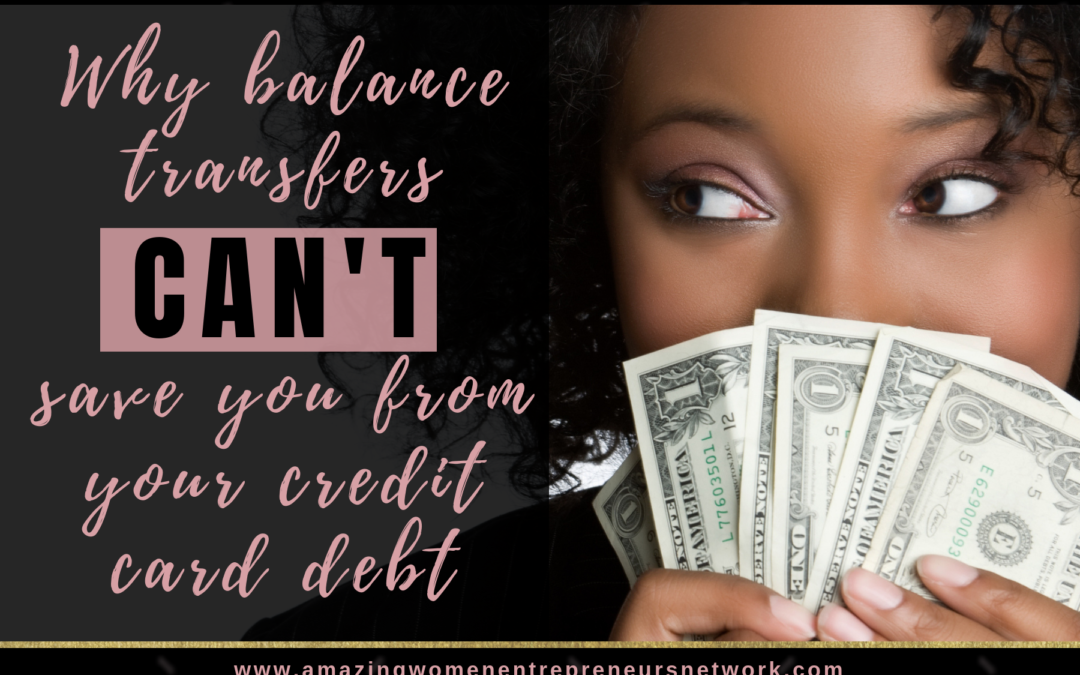If you’re feeling overwhelmed with your credit card debt, you likely have contemplated trying to transfer your balance with a zero percent interest offer. This can be a great way to save some money on the interest you are paying, but it also has some pitfalls you need to be aware of before you make the move.
THE RISKS OF MAKING A BALANCE TRANSFER.
Transferring your high-interest credit card balance can seem like a no-brainer. It might buy you a month where you don’t have to make a payment, possibly lower your minimum monthly payment by slightly and can save you from paying those astronomically high-interest rates on your balance. You may be asking yourself “What could possibly go wrong?”
In this article I want to give you some tips on how to make the best of the balance transfer, to make sure it actually helps you to get out of debt, and doesn’t just wind up getting you in more.
One thing that often happens when people take advantage of a balance transfer offer is that they wind up with two credit cards instead of one. Now you have access to credit lines of potentially more than double what you had before…and if you aren’t careful you can easily find yourself with both cards maxed out.
Now, I know what you’re thinking. “That won’t happen to me.” I know you’re trying to be smart and do your very best here to get yourself OUT of debt, not further in it. The problem is that “life” happens and if you aren’t prepared for it – those big whammies that life throws at you are going to find their way right on to that credit card you are swearing right now you won’t use for anything.
SO WHAT DO I MEAN BY THE “WHAMMIES”?
These are the random expenses in life that tend to get us in credit card trouble to begin with. For most people, it’s not the rent, electric bill or car payment that gets them into debt, it’s things like the car breaking down, the air conditioning going out, back to school shopping, kids’ sports registration, or a trip to urgent care that adds to the credit card balance. All of these random or non-recurring expenses that come up often aren’t planned for in the month to month budget, so when they hit they tend to be more than what we planned to spend for the month and land on a credit card.
Here are a list of the most common “whammies” that you should prepare for:
- Car repairs
- Home repairs
- Car registration
- Vacation/Travel
- Tax expenses
- Clothing
- Hobbies/Kids activities
- Gifts
- Annual fees/renewals
- Pet expenses (vet, grooming, boarding, food, etc)
- Medical expenses (copays, prescriptions, etc)
- Quarterly or Semiannual Insurance Payments
This list is by no means all inclusive, each person may have some unique things to add to their own list, but this should give you an idea of what I’m talking about.
It is extremely common that when these expenses hit, they wind up going on a credit card. The more credit line you have access to, the easier it becomes to accidentally let your balance grow out of control.
SO HOW DO I PREVENT THIS?
In order to make the most of your move to a zero percent interest offer, you need to have a plan in place to prevent your balance from unintentionally creeping up (like it did to begin with).
The number one most important thing for you to do to prevent additional, unwanted charges from landing on your credit card is to prepare yourself for the “whammies”.
Take a look at the list above and identify the areas in your life that you are likely to have a whammy hit. If the holidays are approaching you can pretty much guarantee that you are going to be buying some gifts. Maybe you have a vacation approaching, or your car registration will be due in the next six months. Whatever expenses you are already aware of I want you to determine how much you will need for that expense and divide that number by the number of months it will be until you need the money. That will determine the amount you should be saving every month for each particular expense.
For example, if you plan to spend $800 on Christmas and you know it’s four months away, you will need to save $200 a month between now and then to ensure you have the money you want to purchase your gifts.
EXPLAINING THE SAVINGS PLAN STRATEGY.
When it comes to actually getting started with savings, there is some strategy that goes into it.
Many people will begin savings by putting all of their extra funds into one large savings account, often times called their emergency fund. This is not what I’m talking about. Yes, having an emergency fund is important. And the tighter your cash flow is, the more important it is that you have something put into one right away (I recommend starting with $1000, then growing it after you have paid off your debt).
However, the savings accounts I am talking about are going to be for each of these individual expenses.
My favorite two banks for doing this are www.capitalone360.com and www.ally.com banks. Both of these banks allow you to open up to 25 different savings accounts, nickname them for each of your expenses and they don’t charge ANY fees. No minimum balance requirements. No auto-deposit requirements. And no monthly fees, ever. In fact, both banks pay a small bit of interest (between 1-2%) on the money you have in savings. You really can’t beat it!
I have also had clients have luck with unlimited free savings accounts thru their local credit union, so if you already bank with a credit union, you might want to ask about this! Most large banks charge a monthly fee on their savings accounts, have little to no interest that they pay and usually will not allow unlimited free accounts, which is why I recommend the banks listed above.
You can open up your savings accounts and link them to your current checking. Then once a month, just like clockwork, you transfer money to savings for each of these “whammies” so that you have the money there for them when you need it.
WHAT TO LOOK FOR IN A GOOD BALANCE TRANSFER OFFER.
Finding a good balance transfer offer is relatively easy enough. The ideal balance transfer offer would have a zero percent interest rate for at least 18 months. There is usually a balance transfer fee in order to make the transfer, so you will want to know what that fee is and make sure it is less than what you would be paying in interest with the current card. There are lots of balance transfer calculators online, so you can google for one, or use this:
Implementing the steps above can make doing a balance transfer a smart move. It can be tempting to skip the savings accounts in favor of trying to pay down the credit card more quickly, but don’t. The only way to get off the debt roller coaster once and for all is to change your habits around money. While it may feel very counterintuitive, putting money into savings FIRST and then using what is left to start paying off your debt is the best way to ensure that you don’t take one step forward and two steps back.
Best of luck and as always, if you want some help and extra accountability along the way I’m here to help! You can get started by scheduling a free 15 minute Q&A session or by booking your Eureka session today!

- Why balance transfers can't save you from your credit card debt - September 5, 2018
- What about my “Fun Money”? - August 2, 2018
- How to Know When You Can Leave Your 9-5 - July 11, 2018







